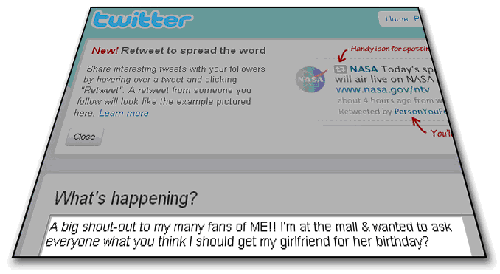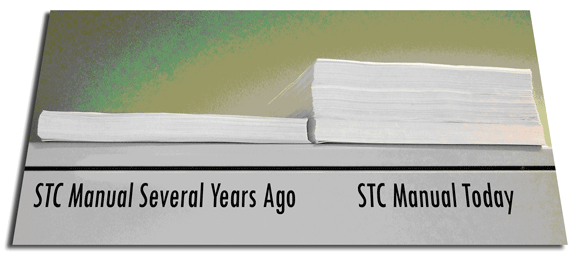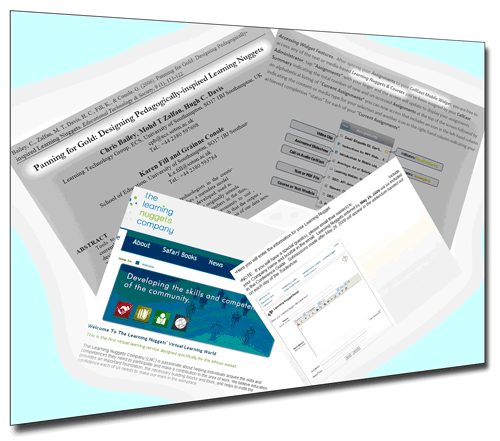Documentation and e-Learning (Part 3): A Nugget for Your Thoughts
By Dave Powell, Documentation Manager, SyberWorks, Inc.
As we’ve mentioned in earlier blogs, future audiences for our training products probably won't have as much patience for extended courseware as did past learners. I can think of two reasons for this:
- A growing impatience with large amounts of un-engaging text.
- A growing use of small, portable information display devices.
Impatience with Text
Kids in high school and college now habitually seek much of their information through Web blogs, Wikis, Google, Twitter, Facebook, and YouTube. They are all lively, animated, engaging, and often extremely concise delivery channels.
Twitter, for example, limits user posts to 140-character tweets. In case you’re the one person out there who still isn’t on Twitter, here’s what 140 characters (including spaces) looks like:

As a result, a whole new generation of twitterati is learning to send and receive information in these tiny chunks. And YouTube enjoys tens of millions of unique visitors each month, who view video clips averaging only 2 to 2.5 minutes in length.
Both are extremely concise delivery channels!
I mention today’s high-school and college students because they’ll soon become tomorrow’s consumers for our services (if they haven’t already). And after graduation, they may continue to expect compressed training content to be delivered over lively, animated, engaging, and concise channels. They won’t allow themselves to remain bored for long by e-Learning materials that drone on or don't hold their interest. Writers of user documentation have already seen the effects of this trend. As products grow increasingly complex, user-manual page counts have risen.
For example, when I came to SyberWorks several years ago, its SyberWorks Training Center (STC) reference manual was 300 pages long. Today, it’s 1,200 pages and climbing, due to the additions and changes made to the software at customers’ request.

One could hold or reduce these page counts by covering everything in less detail than before, but that’s not a popular approach. So page counts just keep climbing. And as they do, customers’ willingness to crack open product manuals dies. Today, it’s all too common for users to call Customer Support for “quick answers,” because what they want to know is buried in more print than they're willing to process.
As a result, there’s been a movement in the documentation world to create small, modular information chunks that can be combined, recombined, and delivered in varying file formats to devices from desktop PCs to iPhones. The concept is similar to SCORM.
Tiny Screens
And speaking of delivery devices, did you know that one out of every three people on Earth use a cell phone…while only one out of six people use a computer?

What does that portend for the e-Learning industry? Here's a logical exercise:
- More people are using mobile information devices than notebooks or desktop PCs.
- Mobile devices have squinty little screens.
- One can shrink display fonts only so far before they become unreadable.
- Having to scroll up-down and right-left a lot makes users cranky.
- Therefore, smaller screens on portable devices may eventually force all of us to build more concise training pages, with less text and minimal scrolling.
“Learning Nuggets” to the Rescue
Learning Nuggets are tiny content chunks that are so standalone that they can be delivered individually or strung like beads in e-Learning necklaces.
By necessity, these tiny lessonettes focus on single concepts or tasks. They can be developed using existing technologies (like HTML, XHTMS, CSS, JavaScript, and SyberWorks Web Author), and often employ audio, video, Flash animations, Web Demonstrations, educational puzzles, and quizzes.
For example, this short interactive nugget shows people how to compute their effective hourly rate based on the number of hours that they really work, and what their annual salary would be if they were paid for every hour that they do work. I could see it being just one unit in a string of similar standalone learning activities about “personal finance”:
Their authoring technology isn’t what differentiates Learning Nuggets from traditional lessons, though. Their key differentiator is design. Each nugget must be short and able to stand alone, or to sequence with others to meet broader training plans (which can be juggled to suit the backgrounds and needs of individual learners).
Googling “learning nuggets” will give you much more information about the work that’s being done with them:

One commercial adopter (London’s The Learning Nuggets Company) is developing low-cost nugget libraries for educating students in “urban and rural sub-Sahara Africa.” Their subject areas include computing, vocations, management, and even European driving. Other implementers have found that nuggets lend themselves to “open source” kinds of sharing, where nuggets developed by one firm can be picked up by others around the world (as illustrated in the trade-show-registration form at the lower-right of the above illustration).
Technically, there are many approaches to creating and delivering nuggets. But they all seek to provide flexible, low-cost content libraries that can be delivered to as many kinds of user devices as possible…including wireless gizmos carried in pockets.
But Dangers Lurk
In a recent study, the U.K. Qualifications and Curriculum Authority (QCA) found that students aged 14 to 16 (especially) were being taught with “extracts and short stories,” more than with a “sufficiently demanding reading diet” (like novels and textbooks). And the QCA report warned that this condensed instruction was producing students who “lack reading stamina.”
An interesting concept, and it makes one wonder…Could today’s efforts to divide user documentation into ever smaller “reusable chunks” and learning materials into standalone “nuggets” (along with the growing popularity of compressed delivery channels like YouTube, iTunes, and Twitter) similarly erode the “learning stamina.” of my documentation readers and your online students?
It’s something worth watching.
About the Author:
Dave Powell is Documentation Manager for SyberWorks Inc., a privately-held supplier of e-Learning software and training. For the past 15 years, he has written award-winning marketing collateral and user documentation for hardware/software companies like PictureTel, 3Com, Philips Medical Systems, Polaroid, and SyberWorks. Prior to that, he edited and wrote for publications like Computerworld, Infosecurity News, Networking Management, Digital Design, LightWave, Popular Computing, Harvard Business Review, and Leaders. (During that time, he also served as an author and Editorial Advisor for Sesame Street.)
About SyberWorks
SyberWorks, Inc. is a leader in providing Learning Management Systems and custom e-Learning Solutions for Fortune 1000 corporations, higher education, and other organizations. Located in Waltham, Massachusetts, the company serves the multi-billion-dollar e-Learning market. Since 1995, SyberWorks has developed and delivered unique and economical solutions for creating, managing, measuring, and improving e-Learning programs at companies and organizations in the United States, Canada, Europe, and other countries.

